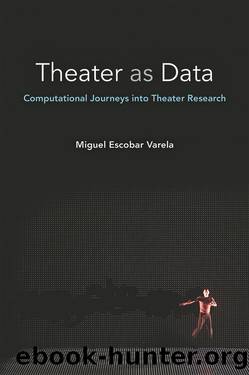Theater as Data: Computational Journeys into Theater Research by Miguel Escobar Varela

Author:Miguel Escobar Varela [Escobar Varela, Miguel]
Language: eng
Format: epub
Tags: PER011020 Performing Arts / Theater / History & Criticism
Publisher: University of Michigan Press
Published: 2021-08-02T00:00:00+00:00
Percentage of characters
Average Weighted Degree
Indian Characters
52.4%
153.47
Javanese Characters
47.6%
73.36
Fig. 5.6. A pairwise matrix comparing the network-theoretical measurements of Javanese and Indian characters.
Page 113 âElsewhere (Schauf and Escobar Varela 2018), we have generated random networks of the same size as this wayang network to estimate the likelihood that the values we see for each character are significant. In another paper, I have also considered differences between the network measurements of characters with a stable puppet representation (i.e., those which cannot be substituted other puppet), and serambahan or âwildcardâ characters that can be represented by many puppets (Escobar Varela 2019).
The question of the interaction between Javanese and Indian characters can be answered with data, but the pertinence of the question itself Page 114 âis open to other modes of critical analysis. Many dhalangs and Javanese scholars are interested in this issue, as can be seen from wayang dictionaries published in Indonesia that almost always indicate when Javanese characters are also found in the Indian versions of the stories. However, this line of inquiry can also be traced to the concerns of colonial-era Dutch scholars. In a previously quoted paper, I have also given a fuller account of how colonial scholarship has shaped this question and how it has changed in postcolonial Indonesia (Escobar Varela 2019). This data experiment should not be used to draw definite conclusions about wayang. As noted above, the dataset I used is relatively limited and the addition of more data will further refine the insights that network analysis can bring in to the analysis of Javanese wayangâs history. However, the method of using pairplots to visualize differences across types of nodes in a network, and the practice of reporting effect sizes, can certainly be applied to other types of fictional and collaborative networks.
Download
This site does not store any files on its server. We only index and link to content provided by other sites. Please contact the content providers to delete copyright contents if any and email us, we'll remove relevant links or contents immediately.
Call Me by Your Name by André Aciman(20380)
Ready Player One by Cline Ernest(14534)
How to Be a Bawse: A Guide to Conquering Life by Lilly Singh(7397)
Wiseguy by Nicholas Pileggi(5675)
The Kite Runner by Khaled Hosseini(5088)
On Writing A Memoir of the Craft by Stephen King(4866)
Audition by Ryu Murakami(4856)
The Crown by Robert Lacey(4732)
Call me by your name by Andre Aciman(4624)
Gerald's Game by Stephen King(4584)
Harry Potter and the Cursed Child: The Journey by Harry Potter Theatrical Productions(4446)
Dialogue by Robert McKee(4328)
The Perils of Being Moderately Famous by Soha Ali Khan(4171)
Dynamic Alignment Through Imagery by Eric Franklin(4126)
Apollo 8 by Jeffrey Kluger(3640)
Seriously... I'm Kidding by Ellen DeGeneres(3578)
The Inner Game of Tennis by W. Timothy Gallwey(3576)
How to be Champion: My Autobiography by Sarah Millican(3558)
Darker by E L James(3482)
